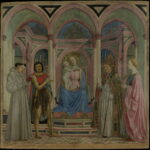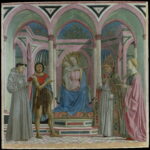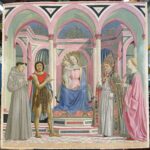The Altarpiece of Santa Lucia dei Magnoli, a Renaissance masterpiece by Domenico Veneziano, has been restored to its extraordinarily vivid original colors by the Opificio delle Pietre Dure in Florence.
Created between 1445 and 1447 for the high altar of the church of Santa Lucia dei Magnoli in Florence, the tempera-on-panel painting depicts the enthroned Madonna and Child flanked by Saint Francis and John the Baptist on the left, Saint Zenobius and Saint Lucy on the right holding her eyes on a plate (they were plucked out, the legend goes, before her martyrdom). Mary sits under a rib vaulted and columned canopy, soft light shining down through the open courtyard. The tops of three orange trees are centered in the pointed arches high in the background.
This work is oldest known example of a rectangular altarpiece without the gold background that was de rigeur in its Gothic predecessors. It is also the first “Sacred Conversation,” ie, a painting of Madonna and Child with saints that are all on the same scale in the same space. Veneziano’s mastery of light, accurate geometric perspective and intricate architectural setting make the St. Lucy altarpiece one of the most important and innovative from 15th century Florence.
The restoration project began in 2019. When the altarpiece entered the collection of the Uffizi Gallery, it was subjected to a drastic cleaning and glazed with an adhesive. This highly invasive intervention damaged the paint and dimmed the brilliance of the colors to the point where they were unrecognizable. Reversing this damage was a complex operation and took even longer than expected thanks to COVID closures.
It was very much worth the wait. The new restoration has brought back to life the brilliant pinks, greens, blues and bright whites of the original paint. The Easter egg technicolor palette lends the scene a surreal, fantastical look. The extraordinary richness of the details, the floor with pink, green and white marble inlay, the fine lettering on the steps, the meticulous patterns in the decorative design on the pedestal under Mary’s feet and on Saint Zenobius’ cope and mitre.
The work will be exhibited to the public for one day only on December 21st at the Laboratory of the Opificio delle Pietre Dure (booking is required). It will return to its permanent home at the Uffizi early next year.


